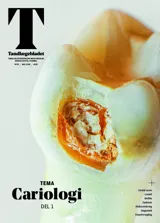Hvad sker der i den dentale biofilm ved cariesaktivitet?
Hos cariesaktive patienter har analyser påvist lokaliserede ”virulens-hotspots” sammensat af flere bakteriearter arrangeret i en coronalignende struktur med en tæt indre kerne af Streptococcus mutans.
Caries er en ikkesmitsom sygdom i de hårde tandvæv initieret af ubalance, dysbiose, i det orale økosystem og en funktionel modifikation af det dentale mikrobiom. Langvarigt indtag af en sukkerholdig diæt har betydelig effekt på mangfoldigheden i den orale mikrobiota, hvilket reducerer populationen af nogle bakterieslægter og -arter og øger mængden af andre. Syretolererende og syreproducerende bakterieslægter, såsom Streptococcus, Scardovia, Veillonella, Rothia, Actinomyces og Lactobacillus, er biomarkører for sygdommen. Høj sukkereksponering fører til øget metabolisk aktivitet og til funktionelle ændringer i det dentale mikrobiom, hvis rumlige struktur er af afgørende betydning i cariesprocessen. Hos cariesaktive patienter har analyser påvist lokaliserede ”virulens-hotspots” sammensat af flere bakteriearter arrangeret i en coronalignende struktur med en tæt indre kerne af Streptococcus mutans. Disse cirkulære hotspots skaber lokaliserede områder med meget lave pH-forhold ved biofilm/tandgrænsefladen, som hurtigt fører til demineralisering af tandens hårdtvæv.
Klinisk relevans:
De moderne molekylærbiologiske metoder har givet nye perspektiver på den dentale biofilms sammensætning, funktion og struktur ved aktiv caries og kan give indikationer på, hvordan sygdommen kan forebygges på en langtidsholdbar måde.
What happens in the dental biofilm during caries activity?
Caries is a non-communicable disease initiated by imbalance, or dysbiosis, of the oral ecosystem and a pH-driven functional modification of the dental microbiome. Long-term consumption of a high-sugar diet has a significant effect of the diversity of the oral microbiota, decreasing the population of some genera and species and increasing the abundance of others. Acid-tolerating and aciduric genera such as Streptococcus, Scardovia, Veillonella, Rothia; Actinomyces and Lactobacillus are biomarkers of the disease. Functional alterations in the dental microbiome are evident as the sugar exposure triggers pathways increasing the metabolic activity. The spatial structure of the microbial community is of pivotal importance. Analyses have detected localized “virulence hotspots” in caries-active patients. Such communities are composed of multiple species arranged in a corona-like structure with a dense inner core of mutans streptococci. Rotund communities create localized regions of highly low pH conditions at the biofilm/tooth interface that is associated with enamel demineralization.


